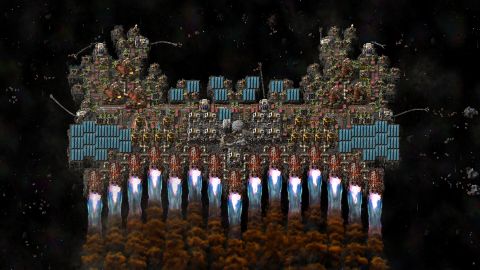Our Verdict
Blowing out Factorio’s scale and reinventing its factory systems multiple times over, Space Age is an immediate contender for the best expansion ever made.
PC Gamer's got your back
What is it? A massive, wildly imaginative expansion to one of PC gaming’s most distinctive creations.
Release date October 21, 2024
Expect to pay $40 / £30
Developer Wube Software
Publisher Wube Software
Reviewed on RTX 2080 Super, AMD Ryzen 5 3600, 32 RAM
Steam Deck Verified
Link Official site
Factorio’s original premise saw players constructing a sprawling manufacturing plant, producing millions of products to fulfil their goal of building a space rocket to escape the alien planet they were stranded on. Doing this was a tremendous feat of planning and engineering, and one of the most challenging, engrossing, and fulfilling experiences I’ve had in a video game.
Factorio: Space Age makes those achievements seem not merely insignificant, but diminutive by comparison. In this massive, galaxy-brained expansion, you’ll be popping off rockets like it’s the fifth of November, your crowning glory reduced to a supporting role in an adventure of mind-boggling interplanetary logistics. Not only does Space Age quadruple the number of visitable worlds in the game, each is so divergent in its geology, challenges, and hazards that you’ll need to completely relearn how to build a functioning factory on each of them.
Indeed, it’s tempting to describe Space Age as a sequel in all but name. Yet while there’s certainly a sequel’s worth of material in Space Age, this description does an injustice to how thoroughly and ingeniously it interweaves with the base game.
Space Age technically begins where Factorio ends, namely once you build a rocket. But developer Wube Software has reworked the process of unlocking rocket technology to streamline your path to the stars. Instead of having to produce five types of ‘science’ to research the relevant tech, you now only need three. Getting to this point still requires a substantial amount of work, and when you finally plant your first rocket silo into the ground, you’ll definitely feel like you’ve earned it. But instead of using your rocket to depart your planetary prison for good, you now use it to launch a space platform into orbit.
What is a space platform? Well, it’s several things, but initially it acts as a celestial extension of your factory on the ground. The space platform is where you manufacture space science, a new research product required to access the broader expansion. As with every other science, it’s produced out of a variety of other resources. In other words, you need to build a factory in space.
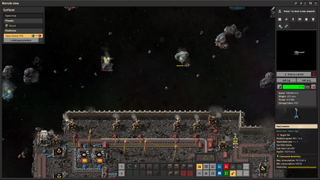
But the space platform functions differently from your factory on the ground. For starters, you don’t construct the platform directly. Instead, you transport the parts you need to create the factory via rocket (including the all-important ‘space platform foundation’ used to expand the platform’s floor area). You then switch to a "remote view" of the platform, using Factorio’s "ghost-builder function" to construct the factory remotely.
This is somewhat idiosyncratic, and I don’t think Space Age does the best job of explaining it. Nonetheless, once you figure it out, the whole production system is incredibly cool. Individual rockets can only carry a small amount of equipment, which means you need the processes in place to build and launch a lot of them. Moreover, once the rocket’s delivery capsule arrives at the platform, it assembles any pre-planned layouts automatically, the platform’s scrapheap-like foundation shifting and writhing as it places conveyor belts and inserters and furnaces into position.
As with constructing the platform, researching space science is done slightly differently from other sciences. You don’t acquire the resources you need by mining, instead, they’re sourced from asteroids using perhaps my favourite new gadget in the expansion—the asteroid collector. These devices attach to the ends of your space platform, and when a small asteroid floats nearby, a big, wavy mechanical arm reaches out and grabs it in pincer-like claws. The animation on these collectors is wonderful—particularly when they shift to catch multiple asteroids without retracting, reacting in the same way you’d snatch at a ball that bounces off your fingertips when you try to catch it. Retrieved asteroids are then crushed by some gnarly-looking rock threshers, producing resources like ice and carbon you transfer to your assembling machines.
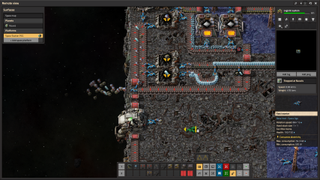
All of this results in a unique factory building challenge. While you can in theory make the space platform as big as you want, you’re still inevitably working in a more limited space than on a whole-ass planet. There are some fun advantages too. Unwanted resources can just be chucked off the edge of the platform with an inserter, for example. This makes initial sorting of asteroids nice and easy, although as with all resources in Factorio, you will eventually want to process as many as you possibly can.
Produced space science is sent back down to the planet via drop-pods (which land inside your cargo landing pad if you remember to build one, otherwise they drop haphazardly onto your factory—not that I would ever do something so stupid, ahem) and used to “discover” four whole new planets, as well as the thrusters you’ll need to get to them. This is where the second function of your space platform comes in. Attach those thrusters to its rear, cook up some propellant, hook everything up, and you’ve got yourself a spaceship, baby.
Travelling between planets is the only time you’ll need to visit your platform personally. Considering Factorio’s top-down perspective and unassuming aesthetic, launching into space (and vice-versa) is impressively evocative—and also completely seamless. But it’s nothing compared to travelling on the space platform itself, which is hair raising. As your mobile factory careens through the void, it’s pelted constantly by much larger asteroids than those collected by your platform’s mechanical arms. Damaged structures are replaced automatically if you have the relevant spares, but you’ll nonetheless need robust turret defences to stop your assembly line from getting wrecked.
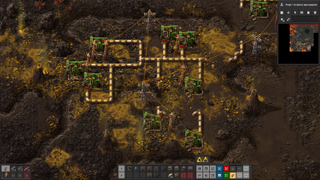
As for which planet you visit, it’s up to you. There’s no defined order in which to tackle them. But whichever one you choose, you’re in for a challenge. If you’ve played Factorio before, chances are you’ll anticipate potential teething problems, and pack your platform with equipment you think you’ll need on the other side: drills, burners, refineries, pumpjacks, maybe the ingredients for a silo and a couple of rockets to get you out of dodge. Thing is, Wube Software has anticipated your anticipation, because when you arrive at a new planet, you’ll soon discover your established factory-building strategies are next to useless.
Take Fulgora, probably my favourite planet of the four. This forsaken sphere is a technological wasteland with oceans of congealed oil and junk piles so old they’ve turned into strata. It’s a world with no “natural” resources, so instead of mining iron and copper ores, you instead drill into seams of rubbish, transporting them to recycling units which spit out semi-random assortments of advanced products.
Shovelling these resources into other recyclers will break them down into their component parts. Hence, building a factory on Fulgora essentially requires you to plan it in reverse, sorting out all the advanced resources and recycling the parts you don’t need to acquire the more basic resources you do. Oh, and the whole planet is wracked by intense lightning storms, which you can harness using lightning rods and battery-like accumulators to power your alien recycling centre.
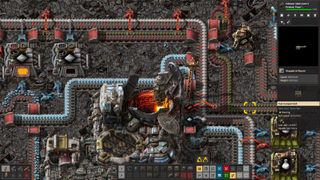
In this manner, each planet has its own unique challenges and rewards, and while Fulgora is probably the most conceptually unusual, even the more familiar sci-fi worlds feel enjoyably strange. Visiting the volcanic world of Vulcanus, for example, unlocks whole new technologies for smelting metal out of lava, while forcing you to contend with giant worms, appropriately called Destroyers, that can bulldoze your factory. On Gleba, meanwhile, you harvest the planet’s verdant biology to build a factory that’s more of a farm, sowing alien seeds and reaping strange fruits and berries that act as character power-ups.
The scale and diversity on show is remarkable. And, of course, everything interrelates and can be fully automated. Not only can you build multiple space platforms, you can program them to run like cargo trains, visiting one planet to collect resources and drop them off at another. It’s utterly captivating stuff, and at the risk of sounding like a stereotype, I genuinely found myself blinking out of a trance to realise it was 3am while reviewing.
Are there problems? Honestly, in a game this complex and flexible (Factorio lets you customise elements like difficulty and map generation to an extensive degree),it can be hard to tell whether something’s a hard issue with the game, or an issue with my own approach to playing it. It was annoying to light the thrusters on the space platform I’d spent ten hours building for it to be immediately obliterated by asteroids, for example. But the problem was I hadn’t built sufficient defences for it.
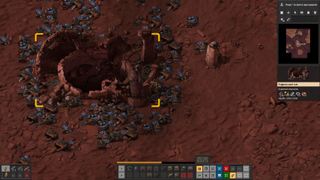
Regardless, I do think Space Age could be better at showing you some of these walls before you run headlong into them. You don’t have to worry about asteroids until you light the torch, so I simply didn’t know what I was running into. I also don’t think the menu for establishing space platform routes is particularly intuitive. It’s great having a dozen conditions to tell the platform when to stay in orbit around a planet and when to travel along its predefined route, but it would also be handy to have some big coloured 'GO' and 'STOP' buttons for those times I do want a bit of manual control.
There are a couple of other, not issues as such, but points of caution worth mentioning. Although you can choose to visit the planets in any order, some of them make better starting points than others. Specifically, I’d advise against visiting Gleba first. While it’s the most enticing planet because of its lush biomes and delightfully strange pentapod creatures, its bizarre ecology and resource spoilage mechanic (where organic material decays after a certain amount of time) make it particularly challenging to build on.
In general, it’s important to stress that Factorio: Space Age is a lot. The base game was a formidable experience, and while Space Age streamlines a few things (giving all inserters the ability to filter resources is a godsend) it ultimately adds far more complexity than it removes. If you found Factorio too overwhelming or finicky in its vanilla form, don’t expect Space Age to address that. And if you haven’t played Factorio before, don’t buy the expansion before trying the base version.
All that said, Space Age is an astounding creation, every bit as unique and absorbing as the game it so cleverly extends and embellishes. The factory building genre is hotly competitive right now, with excellent challengers in the likes of Satisfactory and Dyson Sphere Program. But if Factorio was ever at risk of being supplanted at the top of the production chain, Space Age launches it into the great beyond.
Update: When first posted, this review contained a typo that incorrectly set its score as 90%. Our actual score is 92%, as is now shown correctly on the page.
Blowing out Factorio’s scale and reinventing its factory systems multiple times over, Space Age is an immediate contender for the best expansion ever made.
